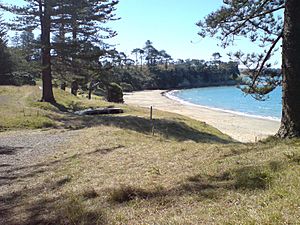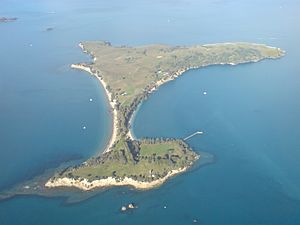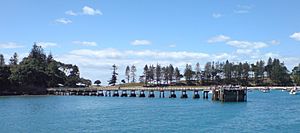Motuihe Island facts for kids
|
Māori: Te Motu-a-Ihenga
|
|
|---|---|

The beach on the northern side of the narrow western neck, separated from the southern beach by about 30 m (33 yd)
|
|

Location of Motuihe Island in the Hauraki Gulf
|
|
| Geography | |
| Coordinates | 36°48′37″S 174°56′49″E / 36.810212°S 174.947019°E |
| Area | 179 ha (440 acres) |
| Administration | |
| Demographics | |
| Population | 1 |
Motuihe Island is a beautiful island located in the Hauraki Gulf of New Zealand, close to Auckland. It sits between Motutapu and Waiheke islands. The island is about 179 ha (440 acres) in size. About 18 ha (44 acres) of this area is covered by old coastal forests.
Motuihe Island is a special place for recreation. It is managed by the Department of Conservation (DOC) and the Motuihe Trust. Many people visit the island for day trips. You can get there by a 30-minute ferry ride from Auckland. You can also arrive by seaplane or private boat. The island is famous for its lovely beaches.
The name Motuihe comes from the Māori name Te Motu-a-Ihenga. This means 'Ihenga's Island'.
Contents
A Look at Motuihe Island's Past
This small island has a very interesting history. It was first settled by Māori people. We know of at least two pā sites on the island. A pā is a fortified Māori village. The Māori people who lived here grew plants like gourds and taro.
Early European Settlement
In 1839, a man named William Fairburn bought Motuihe Island. He bought it from Māori chiefs Ko Nuki, Te Manago, and William Jowett. They were chiefs of the Te Iwi Tutu, Ngāi Tai, and Ngatiwaki tribes. The payment included items like blankets, axes, hoes, and iron pots.
Soon after Europeans arrived, farming started on the island in the 1840s. You can still see groves of Norfolk pines and olive trees from this time.
Motuihe as a Quarantine Station
In 1872, Motuihe Island was chosen as a quarantine station. This was a place to keep people who had diseases like smallpox. A quarantine station was built on the western part of the island in 1873. It was used for nearly 50 years. For example, in 1874, it helped with a scarlet fever outbreak from a ship.
World War I and Famous Prisoners
During the First World War, the station became a prison camp. Its most famous prisoner was Count Felix von Luckner. He was a German naval officer. He and his crew from the ship SMS Seeadler were captured in September 1917.
In December, Luckner used a Christmas play as a clever trick to escape. He gathered supplies and took the island's boat, a scow. He then sailed to the Kermadec Islands. He was caught again there, but he escaped one more time! Many New Zealanders admired him. He was seen as a hero because his daring actions during the war had only caused one death.
After the First World War, the island was used as a quarantine station again. This was during the 1918 flu pandemic.
When World War II began, the buildings on Motuihe became a naval training base. It was called HMNZS Tamaki. New buildings were added for the navy. The base stayed a navy training ground until 1963. After that, its training activities moved to the North Shore mainland.
Protecting Motuihe's Nature
The Motuihe Trust works hard to protect the island's natural environment. They have a plan to remove pests and replant native trees. Rats and mice were removed in 1996. Rabbits were removed in 2004.
Bringing Back Native Animals
This conservation work has allowed native species to return. For example, the North Island saddleback (tieke) has been brought back. The Trust has a small team on the island. Many volunteers also help at the tree nursery and with other conservation projects.
In early 2008, rat footprints were found on the island. This caused a big effort by the trust and DOC to catch the rat. They worried it might be part of a larger group. A special hunting dog eventually caught the Norwegian rat. This meant plans to release native red-fronted parakeets (kākāriki) could go ahead. In May 2008, 31 kākāriki were brought by helicopter from Little Barrier Island.
In March 2009, fifteen little spotted kiwi were released on the island.
Community Planting Efforts
In May 2009, 350 volunteers from The Nikolai Organisation planted many native trees. They planted 22,400 trees in just one day! This was 40% of the total trees planned for 2009.
In 2017, employees and customers from Ricoh New Zealand also helped. They reached their goal of planting 20,000 trees in an area called "Ricoh Valley."
Managing Invasive Plants
Many unwanted weed species grow on Motuihe. Plants like moth plant, woolly nightshade, and rhamnus make it hard for the native forest to grow back. Volunteers work hard to control these invasive plants.



